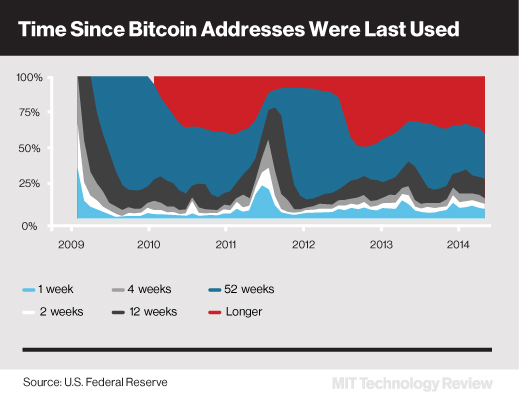Is Bitcoin Stalling?
Bitcoin might someday become a currency that people commonly use to buy retail goods and services, but it has hit a snag. Though the number of merchants accepting the cryptocurrency—including big names like Microsoft, Expedia, and Overstock.com—grew fourfold to 100,000 last year, it appears there has been very little if any increase in retail purchases using Bitcoin.
The price of a bitcoin may be recovering after last month’s plunge (See “Price Slump Tests Bitcoin’s Self-Correcting Economics”), while bitcoin wallets are becoming more common and daily exchanges of bitcoins are steadily increasing. But the currency is still used primarily for online gambling, purchases of illicit goods and services, and speculation, according to several people who closely track its use.
The design of Bitcoin and the blockchain, its public transaction ledger, make it challenging to distinguish specific types of transactions. Nonetheless, researchers from the U.S. Federal Reserve determined in a recent analysis that the currency is “still barely used for payments for goods and services.” Last week, nearly 200,000 bitcoins changed hands each day, on average. But fewer than 5,000 bitcoins per day (worth roughly $1.2 million) are being used for retail transactions, according to estimates by Tim Swanson, head of business development at Melotic, a Hong Kong-based cryptocurrency technology company. After some growth in 2013, retail volume in 2014 was mostly flat, says Swanson.
For many people, the currency simply doesn’t solve a problem, given the convenience and familiarity of using credit cards. Even people who might be inclined to use Bitcoin might be wary of its volatility, as well as the high-profile failures in 2014 of the popular exchanges Mt. Gox and Moolah, says Windsor Holden, who studies cryptocurrency for Juniper Research. Holden estimates that only one in every 4,000 online retail transactions last year was made using Bitcoin.
Besides gambling, hoarding remains among the most popular things to do with bitcoins (see “Cryptocurrency”). The chart below, which uses data gathered by U.S. Federal Reserve researchers, shows that the vast majority of addresses used to hold and exchange bitcoins have been dormant for at least four months. This suggests that bitcoins associated with them were acquired as an investment rather than a means of buying things.

Keep Reading
Most Popular
Large language models can do jaw-dropping things. But nobody knows exactly why.
And that's a problem. Figuring it out is one of the biggest scientific puzzles of our time and a crucial step towards controlling more powerful future models.
The problem with plug-in hybrids? Their drivers.
Plug-in hybrids are often sold as a transition to EVs, but new data from Europe shows we’re still underestimating the emissions they produce.
How scientists traced a mysterious covid case back to six toilets
When wastewater surveillance turns into a hunt for a single infected individual, the ethics get tricky.
Google DeepMind’s new generative model makes Super Mario–like games from scratch
Genie learns how to control games by watching hours and hours of video. It could help train next-gen robots too.
Stay connected
Get the latest updates from
MIT Technology Review
Discover special offers, top stories, upcoming events, and more.